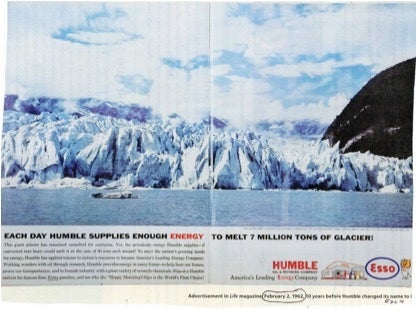The first feeling is a chilling awe, as you watch the British Antarctic Survey’s aerial footage of the great crack that is spreading rapidly along the Larsen C ice shelf. You see the grand vastness of Antarctica absolutely cracked open, like a dropped dinner plate smashed crisply apart. The cliffs of ice descend hundreds of metres to the ocean. And the ocean is dark blue, exposed for the first time in thousands of years.
Scientists are expecting that in a matter of days, the crack will reach the very end of the Larsen C ice shelf and a gigantic iceberg twice the size of Samoa, the size of Delaware, will calve off and collapse into the ocean.
We are petitioning to the US National Ice Center* to change the name of this iceberg to the Exxon Knew 1 iceberg. Let me explain why.
Since the 1950s, the region of the Larsen Ice Shelf has warmed by nearly three degrees (celsius). The Antarctic Peninsula is a window into a distressingly plausible, not-so-distant, future where the relatively stable climate the earth has thrived on enters meltdown mode. Three degrees of warming spread around the whole world is an invocation of terrible suffering. It means drought, famine, sea level rise, more storms, wildfires and worse. I’m usually an optimistic sort, but this scenario leaves me disturbed as I face the prospect of a totally unfamiliar and inhospitable earth.
As Larsen C faces its violent break-up, I’m left with the second feeling: an uncomfortable knot in my stomach. This isn’t an accident. A three degree warmer planet will be no accident.
The pace and extent of global warming from here on in is - for the most part - determined by how much more coal, gas and oil we dig up and burn. To stop global warming from going beyond 2 degrees, which is in itself hardly an optimal goal, requires at least 80% of known fossil fuel reserves to be kept in the ground.
Fossil fuel companies have known the maths of climate change for decades. First they fought hard to knowingly deny it: they spent tens of millions of dollars funding climate denial groups and sought to confuse the public into believing there is great doubt about climate change science. But lies and denial cannot persevere endlessly, eventually they start to crack apart.
When it comes to stymieing action on climate climate change, there aren’t many greater perpetrators than the fossil fuel giant Exxon. In a devastatingly prescient advertisement in the 1962, Humble Energy, a division of the company that would go on to be known as Exxon, ran a full page ad in Life Magazine bragging about their ability to melt glaciers. They say that time makes fools of us all, but Exxon was more than foolish, they were criminally reckless.

After the executive leadership of Exxon shut down their scientific team researching climate change in the 1980s, it then co-conspired to set up the architecture of climate denial. Several decades on, and after successfully delaying global action on climate change, Exxon is facing investigation by the US courts for misleading the public on climate change.
With climate denial cracked apart, fossil fuel companies are now either feigning concern about climate change or taking an approach best described as ‘utter greed’. Last month Peter Coates, the chairman of Santos, a major gas and oil company in Australia, admitted that his company’s business model is based on a scenario of 4 degrees of warming, telling shareholders it was “sensible” and “consistent with good value”. I’ll let you digest that for a moment.
As I dwell upon this fundamental lack of care for fellow humans and life on earth that Santos is guided by, many uncouth words come to mind. But plain and simple, 4 degrees of warming is a death wish for life on earth as we know it now.
There is a relatively small number of privately and state-owned corporations that are absolutely focused on digging their way to profit, no matter how much it warms the earth. Never has so much depended on what happens to a relatively small number of corporations.
It is important that people know companies like Exxon for the climate criminals they are. And that the public understand what their decades of climate denial has led to.
Exxon knew. That is why we are petitioning to the US National Ice Centre to change the name of this iceberg to the Exxon Knew 1 iceberg.
As for the iceberg itself, once it calves off the Larsen C ice shelf scientists believe it will be very unstable, and is likely to disintegrate rapidly. We can only hope that the plans to dig up dangerous amounts of coal, oil and gas will follow suit.
*The blog previously mentioned that we were petitioning the UK Antarctic Place Names Committee, but this has since changed to target the US National Ice Centre as they are responsible for naming icebergs.
